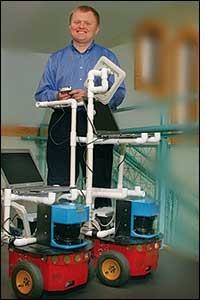Apr 01, 2005Guide dogs for the visually imparied are little help in airports, train stations and other unfamiliar environments. But one researcher thinks a seeing-eye robot that uses RFID technology could be man’s best friend in these places.
Two years ago, Vladimir Kulyukin, a computer science researcher in the Center for Persons with Disabilities at Utah State University, received a grant to develop a robot to assist people with disabilities. He hit on the idea of using a robot with an RFID reader that reads tags in the floor or on walls to guide the visually impaired.
The result of his research is the System for Assisted Navigation in Dynamic and complEx Environments. SANDEE is built on an inexpensive commercial robot platform with a laser range finder that allows the robot to “see” obstacles up to about 25 feet in front of it. The robot is equipped with an electronic keypad plugged into a laptop computer. The laptop is hooked up to a Texas Instruments Series 200 RFID reader with an antenna on an arm made of ordinary PVC pipe. The RFID reader can read 13.56 MHz tags, which are plotted on a grid in the laptop, from about 3 feet. When a tag is read, its ID is fed into the laptop, so the robot knows where it is.
A visually impaired airline passenger would be given a robot to use while in the airport. The robot would have a list of gates, restrooms and other destinations written in Braille, with an associated number. The passenger would find his or her gate and the associated number and punch that into the computer using the keypad. The passenger would then hold a handle attached to the robot and walk behind it as it scanned tags in the floor or on the walls and moved from one tag to another until it reached the right gate. Kulyukin says it “worked flawlessly” in tests. Alas, the robot can do nothing about flight delays.

